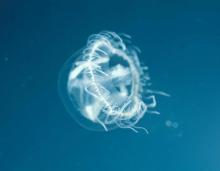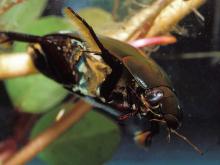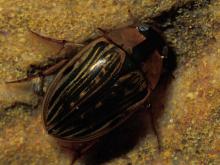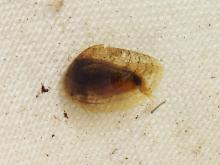Aquatic Invertebrates
Media

Species Types
Scientific Name
Craspedacusta sowerbii (syn. C. sowerbyi)
Description
You may have heard about stinging jellyfish in the ocean, but did you know that there are similar creatures living in the freshwater of Missouri? Fortunately, they’re harmless!
Media

Species Types
Scientific Name
Freshwater species in the phylum Bryozoa
Description
Bryozoans are tiny, filter-feeding invertebrates. They create colonies that can be mossy, branching, or round and jellylike.
Media

Species Types
Scientific Name
About 32 North American species in the family Notonectidae
Description
Sometimes called “water bees” or “water wasps,” backswimmers are predaceous and can deliver a painful bite if mishandled. True to their name, they swim belly-up, and their backs are keeled like a boat, which makes back-swimming easier.
Media

Species Types
Scientific Name
Species in the beetle family Gyrinidae
Description
Groups of whirligig beetles swim on the water surface in quick, random patterns, searching for food. They have two pairs of eyes — one pair above water, one pair below — to help them quickly and accurately capture their prey.
Media

Species Types
Scientific Name
Species in the beetle family Dytiscidae
Description
Like many aquatic insects, these large oval beetles prey voraciously on other aquatic organisms. Excellent swimmers, they fly well, too, and are often attracted to lights.
Media

Species Types
Scientific Name
Beetles in the family Hydrophilidae
Description
Water scavenger beetles are a mostly aquatic family. They are similar to predaceous diving beetles, but unlike them many have a distinctive spine running down the center of their bellies.
Media

Species Types
Scientific Name
Cyclestherida, Laevicaudata, and Spinicaudata (orders or suborders)
Description
Clam shrimp have their carapace shaped like a pair of clam shells and they can close it tightly when disturbed. But they are not clams: they have tiny, jointed shrimplike legs and bristly, feathery antennae.
Media

Species Types
Scientific Name
Pisidium, Sphaerium, and Musculium spp.
Description
Fingernail clams, also called pill clams or pea clams, are members of a family of small to tiny freshwater clams that are common but rarely noticed. They occur in a variety of aquatic habitats.
Media

Species Types
Scientific Name
Corbicula fluminea
Description
The Asian clam is a nonnative, invasive species that lives in a variety of aquatic habitats. It has thick shells with distinctly ridged, concentric rings and a yellowish-brown to dark brown shell covering.
See Also
About Aquatic Invertebrates in Missouri
Missouri's streams, lakes, and other aquatic habitats hold thousands of kinds of invertebrates — worms, freshwater mussels, snails, crayfish, insects, and other animals without backbones. These creatures are vital links in the aquatic food chain, and their presence and numbers tell us a lot about water quality.





















